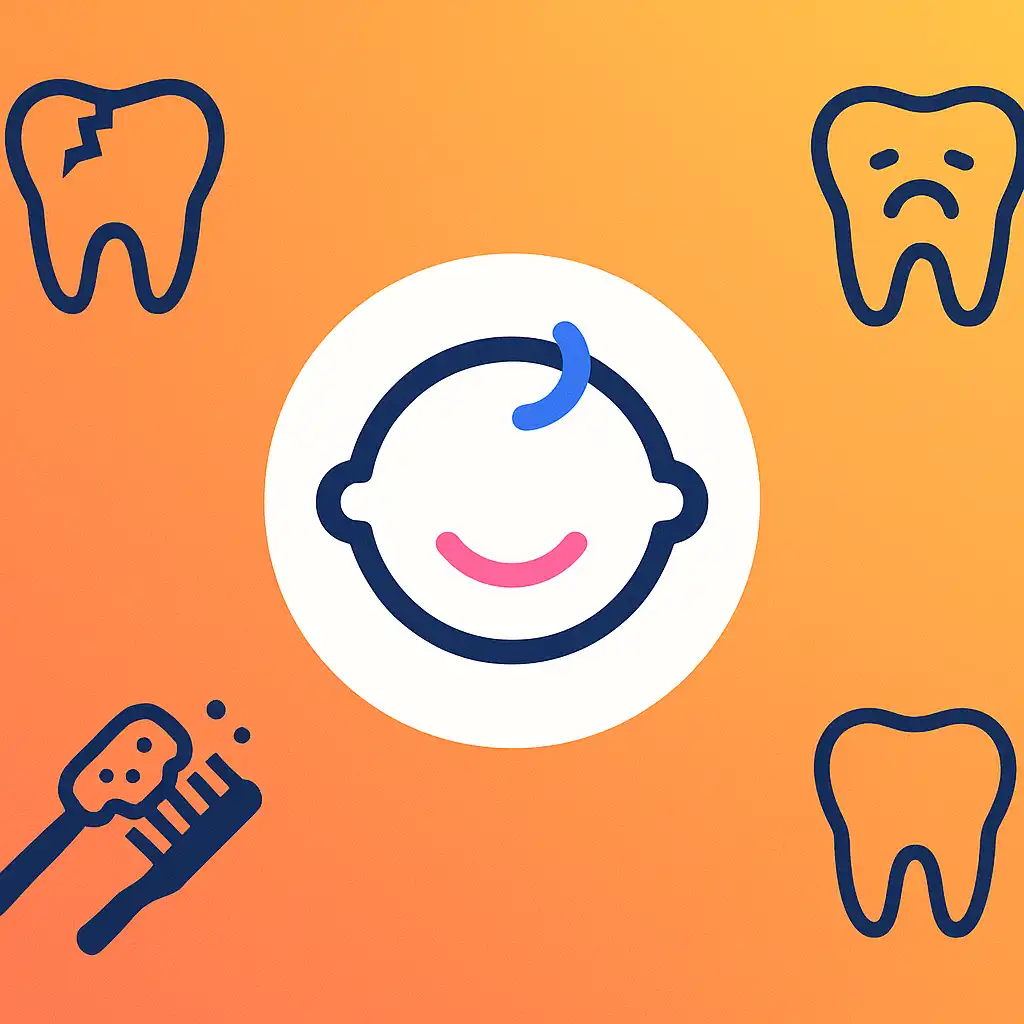Teething is a normal stage in an infant’s first years. It often starts around 4–8 months and can continue until about 30–36 months. The lower front tooth usually appears first and the last molars come in near age three.
Many parents notice irritability, gum swelling, drooling, sleep disruption, mild fever, fussiness with eating, and extra chewing. Around six months, maternal antibodies decline, so minor infections can mimic teething signs. That overlap makes knowing when to call the pediatrician important.
Primary teeth matter beyond a smile. They help with chewing, speech, facial shape, and hold space for permanent teeth. Good daily routines and early dental visits lower the chance of cavities, infection, or misalignment later on.
This article sets clear expectations about the timeline, common signs, soothing steps, and red flags such as high fever or persistent diarrhea. Read on to learn practical care tips and when to seek help so parents can feel confident through each step of the process.
Key Takeaways
- Teething spans the first 2–3 years and follows a predictable sequence.
- Common signs include drooling, gum swelling, irritability, and sleep changes.
- At ~6 months, waning maternal immunity can cause similar illness symptoms.
- Primary teeth support eating, speech, facial growth, and future alignment.
- Seek medical care for high fever, persistent diarrhea, or severe symptoms.
- Early dental visits and steady routines reduce long-term risks.
Teething timeline, first signs, and what’s normal
Knowing which tooth tends to come in first gives useful clues when fussiness starts. Primary teeth usually begin to erupt between 6 and 12 months of age. Lower central incisors often appear first. The top four front teeth follow soon after.
Teeth typically come in pairs and often follow the rule of about four new teeth every six months. The first molars tend to arrive around 13–19 months. Most children have all 20 primary teeth by about 2.5–3 years.
Typical signs vs illness
Common teething symptoms include drooling, red or swollen gums, chewing on objects, short sleep changes, and mild fussiness. These signs are usually brief and mild.
Persistent high fever (≥100.4°F / 38°C), prolonged cough, or heavy congestion suggests an infection rather than teething. Call your pediatrician if fever reaches that level or symptoms worsen.
What a low-grade temperature looks like
A slight temperature rise may occur with eruption, but a reading above 100.4°F is not typical of teething. Track temps and contact a provider if your child develops a true fever.
- Eruption order: lower front first, upper front next, then molars.
- Timing tip: expect individual variation by months and years.
- Molar note: molars can cause more cheek or ear rubbing and be more uncomfortable.
| Age (months/years) | Usual teeth | Common signs |
|---|---|---|
| 6–12 months | Lower central incisors, upper front | Drooling, gum tenderness, chewing |
| 13–19 months | First molars | Increased fussiness, cheek rubbing |
| 24–36 months | Canines, second molars | Short sleep disruption, mild appetite change |
The Best Future Baby Generator App
Discover how your future baby might look with Baby Blend’s cutting-edge AI. Create, explore, and share the joy with just a few taps!
Teeth problems for babies: signs to watch and how to help
New tooth emergence can cause short bursts of fussiness and visible gum changes. Expect drooling, mild swelling, and a child who wants to bite on soft objects. These are common, brief symptoms and often ease with simple care.
Irritability, gum swelling, and pain: gentle ways to help soothe
Close contact and calm cuddles help reduce irritability. Gently massage swollen gums with a clean finger for 1–2 minutes to ease pain and pressure. Offer chilled solid rubber teethers or a cool spoon as safe counter-pressure.
Drooling, skin rashes, and mouth irritation around the gums
Wipe the mouth and cheeks often to prevent saliva rash. Apply a light barrier cream to protect skin. Keep the area dry and check diapers and clothing to avoid extra irritation.
Biting and gnawing: safe teethers, teething rings, and cool spoons
Choose solid chilled teethers and approved teething rings; avoid liquid-filled or frozen rings that can break or be too hard. Avoid benzocaine gels and teething necklaces—both carry safety risks.
Sleep disruption, appetite changes, and chewing on objects
Short-term sleep or appetite changes are normal. Maintain routines and offer cooler, soft foods if age-appropriate to ease discomfort. Supervise any chewing items to prevent choking.
Diarrhea, cough, and ear pulling: when teething may not be the cause
Loose stools can occur, but watery diarrhea, vomiting, or a high fever may signal an infection. Ear pulling and persistent cough paired with fever should prompt a call to your pediatrician to rule out illness and dehydration.
| Common sign | Likely teething? | Safe action | When to call provider |
|---|---|---|---|
| Irritability & gum swelling | Yes, usually | Gum massage, cuddling, chilled teethers | Severe or prolonged pain |
| Drooling & skin rash | Yes | Wipe often, barrier cream | Spreading rash or fever |
| Watery diarrhea or high fever | No—consider illness | Monitor fluids; seek care | Persistent diarrhea, vomiting, fever >100.4°F |
| Ear pulling or cough | Sometimes with molars | Comfort and watch | Ongoing ear pain or fever |
Daily care for healthy baby teeth and gums
Early daily habits protect enamel and support normal speech and chewing. Before any tooth appears, wipe your infant’s gums with a clean, damp cloth after feedings to remove residue and teach a soothing routine.
From first tooth to full set: brushing, fluoride, and when to floss
At the first tooth, gently brush twice daily with a soft brush and a rice-sized smear of fluoride toothpaste. Start to floss when two teeth touch to stop plaque hiding between contacts.
Between ages 3–6, supervise brushing and move to a pea-sized amount of fluoride paste. Schedule a dental visit by the first birthday or within six months of the first tooth to set expectations and catch issues early.
Nutrition tips that support enamel and reduce cavity risk
Choose whole foods, limit frequent sugary snacks and drinks, and offer water between meals to lower acid attacks. Use cups rather than prolonged bottle or sippy use at bedtime to protect developing primary teeth and reduce early decay.
- Begin oral care early: wipe gums after meals.
- Brush at first tooth: rice-sized fluoride, twice daily.
- Floss: once two teeth touch; supervise through preschool years.
When to call the pediatrician or dentist
Trust your instincts. If a child shows signs that seem more than routine discomfort, contact a health professional without delay.
Red flags: fever, diarrhea, and signs of infection
A fever above 100.4°F (38°C) is not typical with normal eruption and should prompt a call to your pediatrician. Persistent watery diarrhea, repeated vomiting, or a cough with cold symptoms can signal an infection and increase dehydration risk.
“A true fever or ongoing gastrointestinal symptoms needs medical assessment to rule out serious illness.”
Seek care if gum swelling has pus, a sore in the mouth won’t heal, or a tooth shows sudden discoloration. These can indicate decay or abscess and need dental attention.
Thumb sucking, pacifier use, jaw and speech concerns
Prolonged thumb sucking or pacifier use can change the jaw and the position of front teeth, sometimes causing an open bite. These shifts may affect speech clarity as children grow.
Talk with your dentist if you notice changing bite, speech delays, or if a primary tooth is lost too early. Early guidance can protect space for permanent teeth and reduce future interventions.
- Call your pediatrician for fever ≥100.4°F, persistent cough, watery diarrhea, vomiting, or ear-pain signs.
- See a dentist for mouth sores that do not heal, pus in gums, or sudden tooth discoloration.
- Discuss pain control and age-appropriate dosing of acetaminophen or ibuprofen with your pediatrician.
- Contact dental care if a primary tooth is knocked out, chipped, or causing intense pain.
- Address prolonged sucking habits early; ask about habit-breaking strategies if jaw shape or speech changes.
| Issue | Likely cause | Recommended action |
|---|---|---|
| Fever ≥100.4°F | Illness, not normal eruption | Call pediatrician; check fluids |
| Watery diarrhea / vomiting | Possible infection or dehydration | Contact pediatrician; monitor intake |
| Prolonged thumb sucking | Jaw growth and bite changes | Ask dentist about timing and strategies |
| Mouth swelling with pus | Dental infection | Seek dental care promptly |
Conclusion
Stay calm, and remember that teething is a gradual process that spans months to years. From the first tooth to the last molars, most infants show mild drooling, gum tenderness, and brief sleep changes.
Keep daily care simple: begin brushing at the first tooth, floss when teeth touch, and keep regular checkups to protect enamel and place for permanent teeth. Use safe soothing like gentle gum massage and cool, solid teethers while avoiding risky products.
Watch for warning signs—high fever, watery diarrhea, or ear pain—which suggest illness rather than typical teething symptoms. With steady routines, good nutrition, and timely care, parents can support healthy development and feel confident every step of the way.





